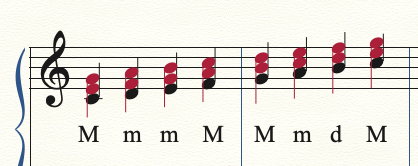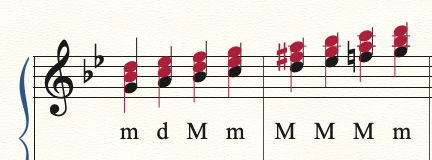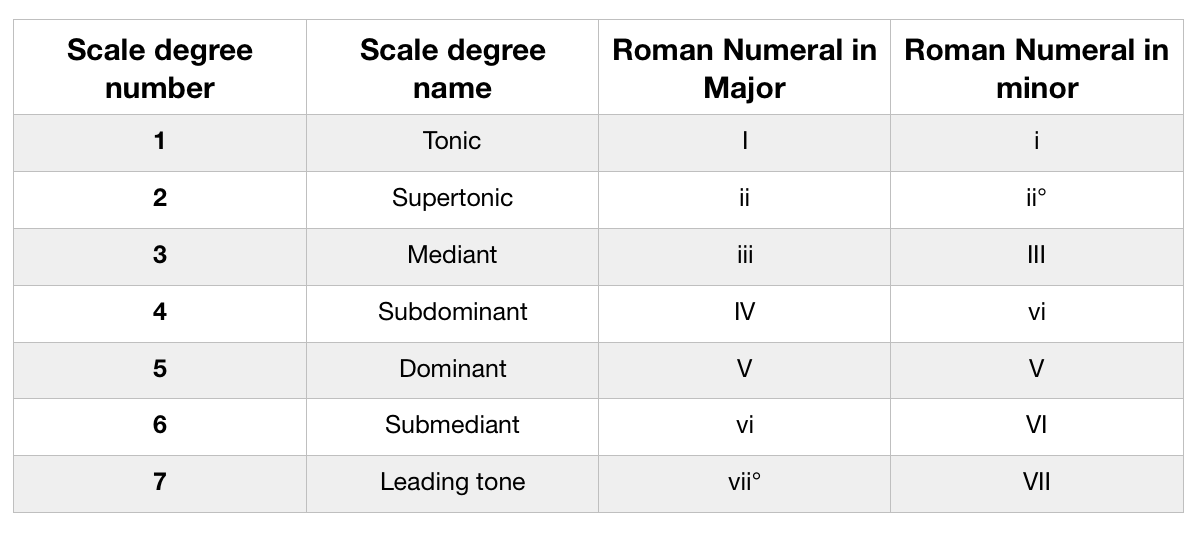3.2 Diatonic Chords and Roman Numerals
7 min read•june 18, 2024
AP Music Theory 🎶
72 resourcesSee Units
There is, indeed, a rhyme and reason to all the various chords that are possible in all keys. Triads and seventh chords are built in the scale degrees of a given key. Diatonic means within the key, or from the notes of the scale of the key.
Diatonic chords are chords that are built using only the notes of a specific scale. For example, if we are working in the key of C major, the diatonic chords would be built using the notes C, D, E, F, G, A, and B. These chords can be major, minor, diminished, or augmented, and they will follow a specific pattern of intervals based on the scale.
Diatonic Chords in Major Keys
There are seven diatonic chords in a major scale, and they are typically referred to by Roman numerals. The chords built on the first, fourth, and fifth scale degrees are major chords, while the chords built on the second, third, and sixth scale degrees are minor chords. The seventh scale degree produces a diminished chord. These chords can be further altered by the addition of accidentals, such as sharps or flats, which will change the chord's quality.
To see how this works, we will do an example. Using the key of C Major, let’s construct all of the diatonic chords of C Major. First, we write the C Major scale:

Now, let’s use the two lines or two spaces above each of the notes of the scale to construct the triad for each scale degree.

The next step is to figure out the quality of each of these chores. Are they Major, minor, diminished, or augmented (M, m, d, A)? Remember, we look back to the quality of the triads within each triad to distinguish each type of chord.

The beauty of finding out the chord-quality patterns of one major scale, is that it applies to all major scales.

Roman numerals are used in music theory to represent chords, and they are often used in conjunction with diatonic chords. Roman numerals are used to identify these chords and indicate their root, or starting note. Remember that if the chord is inverted, then the root still stays the same. The root is the starting note when the chord is not inverted (i.e. in root position). So, in C Major, a GBD is a V chord, but a BDG is also a V chord. We will learn how to use something called figured bass to denote an inversion in Unit 3.3.
In a major key, the diatonic chords are typically referred to by Roman numerals in the following way:
- The chord built on the first scale degree is represented by the Roman numeral I.
- The chord built on the second scale degree is represented by the Roman numeral ii.
- The chord built on the third scale degree is represented by the Roman numeral iii.
- The chord built on the fourth scale degree is represented by the Roman numeral IV.
- The chord built on the fifth scale degree is represented by the Roman numeral V.
- The chord built on the sixth scale degree is represented by the Roman numeral vi.
- The chord built on the seventh scale degree is represented by the Roman numeral vii°.
We can also use the names of the scale degrees to refer to the chords. For example, we can refer to the V chord of any key as the dominant. If we have built a seventh chord on that 5-chord, we can refer to it as the "dominant seventh", which is a very common chord in music. This doesn't change whether it is in major or minor. The same is true with the ii chord. We can refer to it as the “supertonic", which can infer a diminished chord if we are operating in a minor key.
Diatonic Chords in Minor Key
Minor scales take on a different pattern. In a minor key, the diatonic chords are represented in a similar way, but with the exception that the chords built on the third, fifth, and sixth scale degrees are typically major chords and the chords built in the first and fourth scale degrees are usually minor. The chord built on the second scale degree is usually diminished.
The seventh scale degree can be a little tricky. If we use the harmonic minor and sharp the seventh scale degree, then we have a diminished seven chord. However, if we use natural minor and we don’t sharp the seven, then we just get a major chord! Composers will use both the major seven chord and the diminished seven chord in different contexts in music, but the major seven chord is usually more common.
Let’s illustrate this with an example. We will use the example of a g minor scale:

Now let's build the chords on top of each scale degree:

Note: For the V-chord, we actually make it into a major chord by altering the third of the chord. In a minor key, the V chord is naturally minor, but to keep it always as a major chord, we raise the third by a half-step. Look at the image below to see what that looks like.
And finally, let's discover what the quality of those chords are by identifying their triads.

Notice that the second to last chord, the VII chord, is considered Major when built from the natural minor scale. When the scale is a harmonic minor or melodic minor scale, the F natural becomes an F# (hence, why the Dominant takes an F# in the triad). This will also make the VII chord turn into a diminished chord. For this reason, the seventh chord in minor can be both Major or diminished, based on which type of minor the composer uses.
Chords of any key can also be identified using the scale degree names of each chord's respective root.
Take note, there are no naturally occurring augmented chords based on the diatonic scale. Augmented chords must be altered from a Major chord!
Here is a summary of all of the scale degrees, their names, and their roman numerals in both Major and minor. Ingrain this information into your skull! You will need it for the rest of the material on the AP Music Theory test!

*Take note, there are no naturally occurring augmented chords based on the diatonic scale. Augmented chords must be altered from a Major chord!
🦜 Polly wants a progress tracker: Can you spell all the diatonic triads in the key of B Major? How do you spell a dominant chord in the key of A Major?
Introduction to Chord Progressions and Harmonies
Now that we know a little bit about diatonic chords, we can start talking a little bit about chord progressions. Chord progressions are sequences of chords that move from one to another and create a sense of motion and direction in a piece of music. In classical music, chord progressions are an important element of the musical structure and are used to create a wide range of moods and emotions. There are many different chord progressions used in classical music, and they can vary widely in complexity and length.
One of the most common chord progressions used in classical music is the tonic-dominant progression, which consists of the tonic chord (the chord built on the first scale degree) and the dominant chord (the chord built on the fifth scale degree). This progression creates a sense of stability and resolution and is used in many different types of classical music.
Another common chord progression in classical music is the I-IV-V progression, which consists of the tonic chord, the subdominant chord (the chord built on the fourth scale degree), and the dominant chord. This progression is often used in classical music to create a sense of motion and momentum, and it is similar to the 12-bar blues progression used in blues and rock music.
In addition to these basic chord progressions, classical composers also often use more complex and varied chord progressions to create a wide range of moods and emotions. For example, the chord progression in the first movement of Beethoven's Symphony No. 5 is a famous example of the use of a complex and varied chord progression to create a sense of tension and drama. The progression moves through a series of chords that create a sense of instability and dissonance before resolving on the tonic chord, creating a sense of resolution and closure.
Classical composers also often use inversions of chords and dissonant chords to create interest and variety in their chord progressions. Dissonant chords are chords that contain intervals that create a sense of tension or instability. These techniques can add depth and complexity to a chord progression and create a wide range of moods and emotions.
Overall, chord progressions are an important element of classical music and are used to create a sense of structure, motion, and emotion in a piece of music. They vary widely in complexity and length and can be used to create a wide range of moods and emotions. Chord progressions are an essential part of the musical language of classical music and are an important element of many different styles and traditions.
Browse Study Guides By Unit
🎵Unit 1 – Music Fundamentals I (Pitch, Major Scales and Key Signatures, Rhythm, Meter, and Expressive Elements)
🎶Unit 2 – Music Fundamentals II (Minor Scales and Key Signatures, Melody, Timbre, and Texture)
🎻Unit 3 – Music Fundamentals III (Triads and Seventh Chords)
🎹Unit 4 – Harmony and Voice Leading I (Chord Function, Cadence, and Phrase)
🎸Unit 5: Harmony and Voice Leading II: Chord Progressions and Predominant Function
🎺Unit 6 – Harmony and Voice Leading III (Embellishments, Motives, and Melodic Devices)
🎤Unit 7 – Harmony and Voice Leading IV (Secondary Function)
🎷Unit 8 – Modes & Form
🧐Exam Skills
📚Study Tools

Fiveable
Resources
© 2025 Fiveable Inc. All rights reserved.